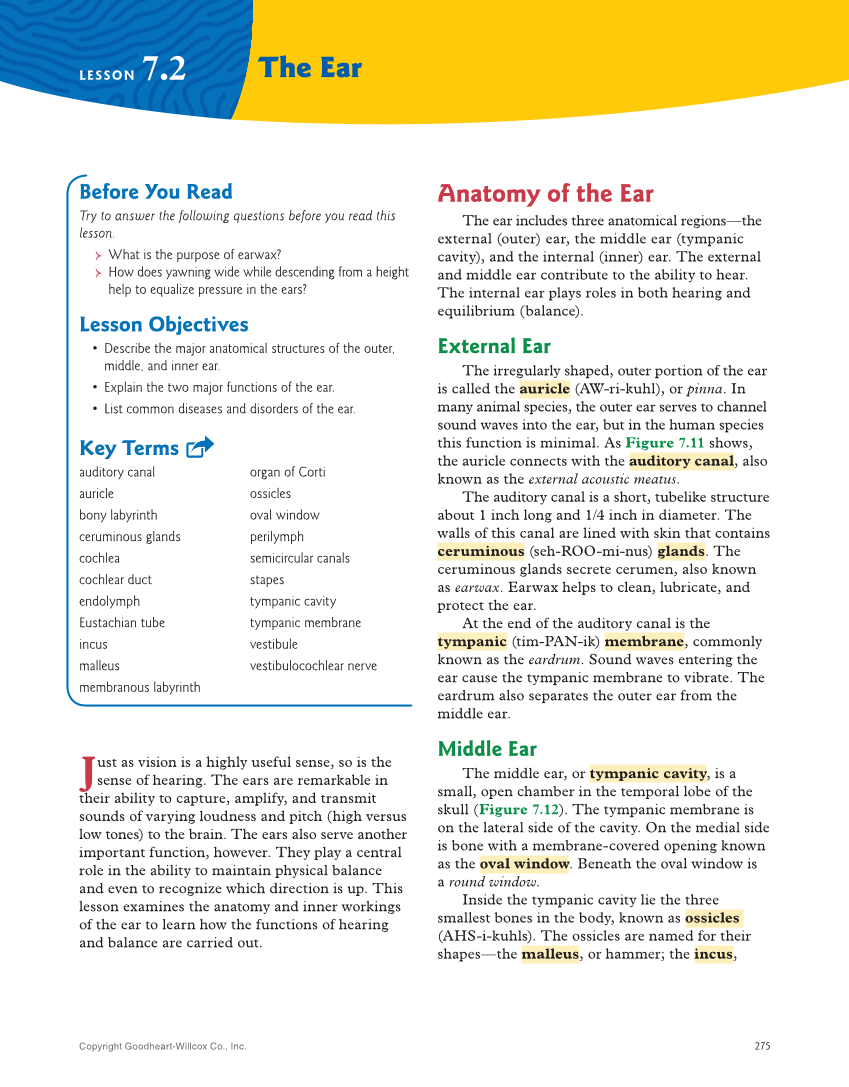275 Anatomy of the Ear The ear includes three anatomical regions—the external (outer) ear, the middle ear (tympanic cavity), and the internal (inner) ear. The external and middle ear contribute to the ability to hear. The internal ear plays roles in both hearing and equilibrium (balance). External Ear The irregularly shaped, outer portion of the ear is called the auricle (AW-ri-kuhl), or pinna. In many animal species, the outer ear serves to channel sound waves into the ear, but in the human species this function is minimal. As Figure 7.11 shows, the auricle connects with the auditory canal, also known as the external acoustic meatus. The auditory canal is a short, tubelike structure about 1 inch long and 1/4 inch in diameter. The walls of this canal are lined with skin that contains ceruminous (seh-ROO-mi-nus) glands. The ceruminous glands secrete cerumen, also known as earwax. Earwax helps to clean, lubricate, and protect the ear. At the end of the auditory canal is the tympanic (tim-PAN-ik) membrane, commonly known as the eardrum. Sound waves entering the ear cause the tympanic membrane to vibrate. The eardrum also separates the outer ear from the middle ear. Middle Ear The middle ear, or tympanic cavity, is a small, open chamber in the temporal lobe of the skull (Figure 7.12). The tympanic membrane is on the lateral side of the cavity. On the medial side is bone with a membrane-covered opening known as the oval window. Beneath the oval window is a round window. Inside the tympanic cavity lie the three smallest bones in the body, known as ossicles (AHS-i-kuhls). The ossicles are named for their shapes—the malleus, or hammer the incus, Before You Read Try to answer the following questions before you read this lesson. What is the purpose of earwax? How does yawning wide while descending from a height help to equalize pressure in the ears? Lesson Objectives • Describe the major anatomical structures of the outer, middle, and inner ear. • Explain the two major functions of the ear. • List common diseases and disorders of the ear. Key Terms auditory canal auricle bony labyrinth ceruminous glands cochlea cochlear duct endolymph Eustachian tube incus malleus membranous labyrinth organ of Corti ossicles oval window perilymph semicircular canals stapes tympanic cavity tympanic membrane vestibule vestibulocochlear nerve Just as vision is a highly useful sense, so is the sense of hearing. The ears are remarkable in their ability to capture, amplify, and transmit sounds of varying loudness and pitch (high versus low tones) to the brain. The ears also serve another important function, however. They play a central role in the ability to maintain physical balance and even to recognize which direction is up. This lesson examines the anatomy and inner workings of the ear to learn how the functions of hearing and balance are carried out. LESSON 7.2 The Ear Copyright Goodheart-Willcox Co., Inc.
